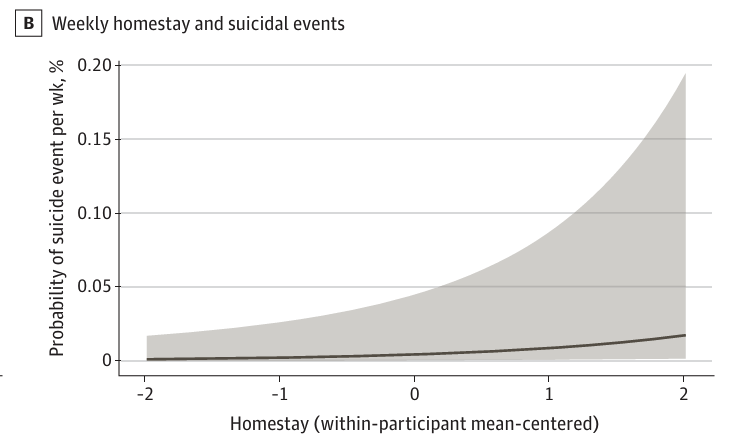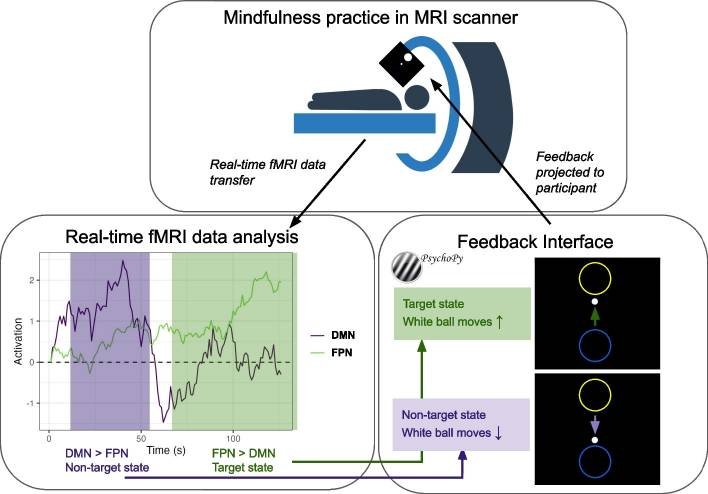Select publications are highlighted below. You can find a full list of my publications on Google Scholar and PubMED
Using Smartphone GPS Data to Detect the Risk of Adolescent Suicidal Thoughts and Behaviors
This study investigated whether geolocation data from adolescents' smartphones could predict short-term suicide risk. This study (MAPS) tracked 186 adolescents with a history of suicidal thoughts and behaviors or current psychopathology, collecting passively recorded GPS data alongside weekly experience sampling over six months. Findings revealed that increased time spent at home (homestay) relative to an individual’s average was associated with approximately twice the odds of a suicidal event in the following week. These results suggest that smartphone sensor data may capture real-time affective and behavioral dynamics that signal heightened suicide risk, offering a potential avenue for timely intervention. However, the predictive accuracy was modest, highlighting the need for further research to determine whether such digital markers can be effectively integrated into clinical decision-making.
JAMA Network Open, 2025
Identifying Factors Impacting Missingness within Smartphone-based Research: Implications for Intensive Longitudinal Studies of Adolescent Suicidal Thoughts and Behaviors
Missing data poses substantial challenges to longitudinal research on mental health. This study worked to characterize patterns of missing data among adolescents with psychiatric disorders and at risk for suicide, in particular missingness of smartphone-based surveys and measurements passively collected from participants’ smartphones (e.g., GPS, accelerometer, keyboard). Findings highlight key technical and study design factors that should be considered to minimize missing data and maximize the validity of results in future longitudinal studies using smartphones.
Journal of Psychopathology and Clinical Science, 2024
Mindfulness-based real-time fMRI neurofeedback: a randomized controlled trial to optimize dosing for depressed adolescents
Adolescents (N = 90) with a current diagnosis of MDD ages 13–18-years-old will be randomized in a parallel group, two-arm, superiority trial to receive either 15 or 30 min of mbNF with a 1:1 allocation ratio. Real-time neurofeedback based on activation of the frontoparietal network (FPN) relative to the DMN will be displayed to participants via the movement of a ball on a computer screen while participants practice mindfulness in the scanner. We hypothesize that within-DMN (medial prefrontal cortex [mPFC] with posterior cingulate cortex [PCC]) functional connectivity will be reduced following mbNF (Aim 1: Target Engagement). Additionally, we hypothesize that participants in the 30-min mbNF condition will show greater reductions in within-DMN functional connectivity (Aim 2: Dosing Impact on Target Engagement). Aim 1 will analyze data from all participants as a single-group, and Aim 2 will leverage the randomized assignment to analyze data as a parallel-group trial. Secondary analyses will probe changes in depressive symptoms and rumination.
BMC Psychiatry, 2023
Age‐related change in task‐evoked amygdala—prefrontal circuitry: A multiverse approach with an accelerated longitudinal cohort aged 4–22 years
DOI I PDF | Code | Interactive Multiverse Data Visualization App | OSF
The amygdala and its connections with medial prefrontal cortex (mPFC) play central roles in the development of emotional processes. While several studies have suggested that this circuitry exhibits functional changes across the first two decades of life, findings have been mixed - perhaps resulting from differences in analytic choices across studies. Here we used multiverse analyses to examine the robustness of task-based amygdala—mPFC function findings to analytic choices within the context of an accelerated longitudinal design (4–22 years-old; N = 98; 183 scans; 1–3 scans/participant). Participants recruited from the greater Los Angeles area completed an event-related emotional face (fear, neutral) task. Parallel analyses varying in preprocessing and modeling choices found that age-related change estimates for amygdala reactivity were more robust than task-evoked amygdala—mPFC functional connectivity to varied analytical choices. Specification curves indicated evidence for age-related decreases in amygdala reactivity to faces, though within-participant changes in amygdala reactivity could not be differentiated from between-participant differences. In contrast, amygdala—mPFC functional connectivity results varied across methods much more, and evidence for age-related change in amygdala—mPFC connectivity was not consistent. Generalized psychophysiological interaction (gPPI) measurements of connectivity were especially sensitive to whether a deconvolution step was applied. Our findings demonstrate the importance of assessing the robustness of findings to analysis choices, although the age-related changes in our current work cannot be overinterpreted given low test–retest reliability. Together, these findings highlight both the challenges in estimating developmental change in longitudinal cohorts and the value of multiverse approaches in developmental neuroimaging for assessing robustness of results.
Human Brain Mapping, 2022



